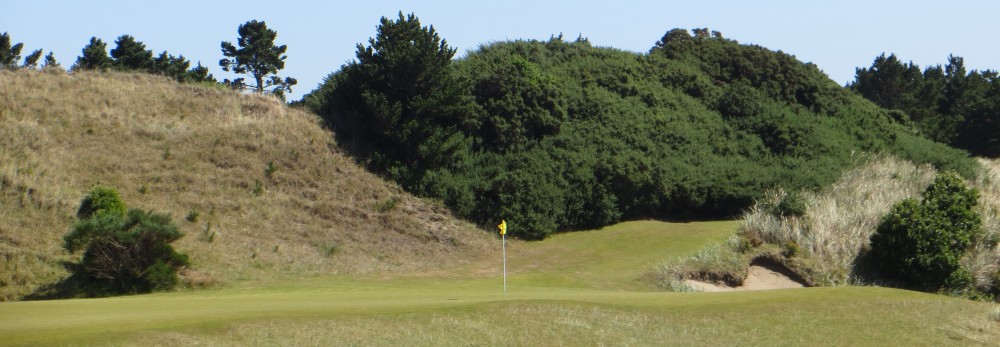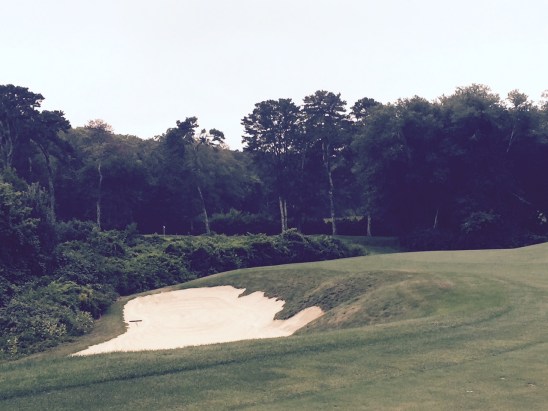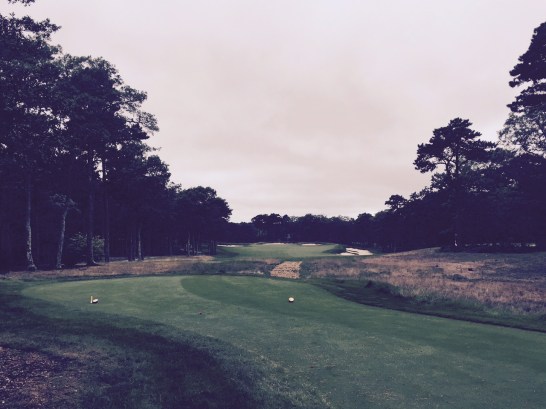
Glen Oaks is a delightful collection of 27 holes in Old Westbury, New York along the way to Long Island. It is a private club with a relatively small membership that fosters a hamish atmosphere making for a warm welcome to all who visit. Since the volume of play is delimited by the membership size, there are no tee times which makes access very convenient if you are lucky enough to get a member to host you to play.
The original three nines were done in 1972 by Joe Finger. A master plan for renovating the place was begun in 2011 by Joel Weiman to be done over a four year period. In 2012 Hurricane Sandy did extensive damage to the course which forced them to retool the master plan on the fly. With the help of the Greens Super Craig Currier who had previously been involved at Bethpage Black, Joel did the work that you see presented today.
As the pictures indicate the removal of enormous swaths of trees taken down by the storm allowed them to present a marvelous array of holes with requisite width to encourage strategic play and wide visibility of the entirety of the property during play. The greens have plenty of internal slope and segmentation and the bunkers have tall white faces and sharp edges which when set in the hillier terrain give the place a bit of an Augusta feel.
A PGA Tour playoff event was played here in 2017 where Dustin Johnson beat Jordan Spieth in a riveting playoff. No matter which of the nines you get to play I am sure you will find it a delightful experience of tactical golf. Don’t miss two highlights during your visit, the men’s locker room and adjacent card room/man-cave and the amazing brunch they serve every day in the main dining room. Both will knock your socks off.
Hole-By-Hole Analysis (Red/White):
Red Nine
#1 Par 4 402/340 yards

Fairly simple opening hole, this driving area leans right to left toward the fairway bunker. Drive it up the right edge of the rough line and let it drift to center. Green slightly raised is accessible between flanking bunkers short right and middle left.
#2 Par 4 370/350
Similar in length to the first but this one is flatter with no fairway bunkering to consider. Drive to center and the approach is to a green slightly below you. Front left bunker is pretty deep so aiming to the right side on the approach where the right bunker is set back in the middle of the green is sensible.
#3 Par 3 160/150

First of the eye candy holes that express the expansive and clean presentation of the character of these courses. Significantly downhill, requires a one club adjustment into a green flanked by deep sharp edged bunkers. Green tilts back to front and left to right with a significant transition ridge from 9 to 3.
#4 Par 5 550/520

The confectionary look continues on a spectacular visual five par off a high perched tee into the valley below. The hole turns to the left around a horseshoe fairway bunker that is probably within reach. Best drive is center just off the bunker-don’t bail right off the tee as the rough and tree line on that side will cause problems for your second.

The green is a true fortress-rings of bunkers protect the full surrounds-a few trolls with boiling oil may be prowling the top edge as well. Lay up is left center to about 110 which leaves an intimidating looking approach into a green that is very generous. Lots of slope here back to front so challenge the pin yardage of the day.
#5 Par 4 400/370
For a relatively flat hole this one has great visual impact created by the alcove driving area and the hill framing the back of the green. Drive to left center to leave a mid-iron approach into an accessible green. One greenside bunker on the left and a second framing bunker behind the green on the right, so the error on approach is short and right. Green leans 11 to 5 so from the front right you can be aggressive on a pitch.
#6 Par 4 405/355
One of the truly splendific looking holes of the day. This is a graceful uphill par four with a perched green framed on the horizon by a lone oak tree 40 yards right of the green. Drive right center of a landing area adjacent to the fairway bunker on the right. The hole climbs after that so the approach plays a full club and a half longer into a green with one bunker left and plenty of open grass on the right. They did a great job of letting the topography give this hole it’s character.
#7 Par 4 360/350
A shortish par four that leans left to right around a pair of bunkers that flank the driving area. The temptation is to aim well left off the tee but this can give you a perch side hill lie in the rough into the green that sits above you. Take on the left edge of the bunkers on the right as the fairway widens just beyond and you can have a short club in your hand making the approach much easier. Green sits on a 7 to 1 diagonal with fierce bunkers protecting the right and plenty of short grass surrounds left and behind the green. The green climbs on the same 7 to 1 line so putts and pitches up this line need the requisite intent to reach the hole.
#8 Par 3 130/120

A delightful short pitch Par 3 that is their homage to the Postage Stamp. Pitch is on level to the tee but the narrow green set on a 6:30 to 12:30 angle is tightly surrounded by massive bunkers. This gives you little choice but to hit an articulate lawn dart just below the hole position of the day. There are steps in the green along it’s setting angle and the pins to the right are much harder to get at. Middle of the green to any pin to the right is proper discretion.
#9 Par 5 550/500

This nine finishes with a three-shot five par with plenty of topographical interest. Drive to left center to avoid the fairway bunker on the right and the drop off of the fairway into the rough and trees on that side. The lay-up is down the left into the valley that will give you a view back up the hill toward the foot of the dining room patio where the green resides a bit to the right. Green has lots of sand surrounds but note that the first bunker on the right is set 50 yards way from the bunker creating a friendly miss area if you don’t want to take on the pin of the day. Green is stepped from 7 to 1 with a ridge across the center so getting an approach to the proper level is essential to avoid the three-putt opportunity.
White Nine
#1 Par 4 515/480 yards
The first of the White Nine is a very user friendly dogear left Par 5 that gently climbs from the landing area to a green perched up on top of the rise. From the tee the hole appears to lean to the right so a right-to-left drive just right of the two fairway bunkers on the corner is called for. Depending on what you have left this could be reachable in two, but if not the lay up is to about 100 yards short of the first bunker on the right which is set well back from the putting surface. The kidney shaped green wraps around a deep bunker on the front right and has an open short grass area to the left for a safer approach.
#2 Par 3 205/190

The second is feisty longer sister to the downhill Par 3 third on the Red. A stunning view from the perched tee box, it ambles down the same sttep hill as it’s sister playing a full club and a half less then the distance. A quasi-reverse Redan arrangement the green curves around to the right behind a yawning bunker set into the right slope of the hill. The difference from a Redan is that the first part of the green is not banked to match the curve of the green so you do not get the benefit of the ground directing your ball toward the back right pin locations. There is also a pesky ridge that cuts across the center of the green creating two distinct levels. For the front level an approach landing right of the flag will feed to the left. For the back level you have to settle for a shot in the center of the green and then putt up and over the ridge because anything landing on the top level takes a downslope off the back of the green.
#3 Par 4 410/375

This next Par 4 has lots of visual interest but lacks strategic continuity for me. From the elevated tee you see a sharp dogleg left working around a bank of trees, but there is this pesky water hazard gathering your attention straight through the right center driving line. For big hitters the penalty area is definitely within reach. If you manage to hit the drive to center between the bunkers on the left corner and the water you now have a slightly ramped up approach to a green sitting below the Halfway House. It is set 7 to 1 behind big face bunker on the right and a pinching bunker behind the green on the right. The bunker on the left is set back so there is a bit of breathing room on that side if you don’t want to take on a pin set behind the right bunker. This is another green with serious lean from back to front.
#4 Par 4 415/380
The next four holes present an interesting run of holes played in distinct corridors of the trees where ball position matters. This is a straight away par four-you drive to left center into a downhill landing area that will feed the ball a little right. The green complex sits below framed by trees and bunkers providing a very appetizing open access approach for a middle iron to hybrid. There is a short grass area back and left of the green if you overcook a draw. This green is deep so pay close attention to your actual shot yardage to reach the day’s pin or you can have a very long first putt over some challenging contour.
#5 Par 4 295/270

This one falls into the drivable Par 4 category for some but should provide a good scoring chance for anyone who can hit a couple of articulate shots. For most of us the choice off the tee is not more then 200 yards aimed at the bunker on the left. This leaves a short wedge into a diagonally set narrow green that is squeezed by bunkers on both sides. This hole can only help your scorecard as long as you don’t do anything silly.
#6 Par 3 165/140

More eye candy this shortish three par has a slightly downhill approach worth a half a club less to a tiered green setting protected by a pond across two-thirds of the green. The sharp top edge of the stone wall accent of the pond gives it a clean look that also clearly defines for your eye the required carry to pins center and right. There is a back right bunker that further frames the challenge of a pin on the section. Pins on the left allow you to skip one up the throat between the pond and the left greenside bunker and should provide a birdie opportunity.
#7 Par 5 520/470
This is a very technical four and a half Par 5 that takes real discipline if you want to take advantage. From a slightly perched tee drive it to center using the slope from the left tree line to help you. If the green is out of reach, as it is for most mortals, there is a receptive lay up area beyond the right fairway bunker at about 160. This shot will feed down to the right and gives a you a good look at the coffee table green set back to the left. The green is very deep and sharply inclined from back to front with a bunker front left and another two-thirds of the way back on the right so you need to take careful measure on your approach to give yourself a reasonable putting chance.
#8 Par 4 360/320

One of the most unusual challenges you will get all day this is a short drive and pitch Par 4 that turns around a fierce constellation of five bunkers set into the topographical rise on the left. It is likely there was once a grove of trees in this spot that were lost to the hurricane that delineated and separated this hole from an adjacent hole on the Blue Nine so they needed to find a hazard penal enough to replicate the interference of the trees. Tee ball needs to be well right of the fairway hazard which will leave a short iron pitch up a very steep grade to a generous green surface you cannot see perched behind a very deep bunker on the right. On the approach long is the miss since a 50 foot putt is much better then the 3-story pitch you would have to play out of the front bunker.
#9 Par 4 400/370
This nine finishes with a very strong roller coaster Par 4. Drive strong to left center and you should be looking at a steep uphill shot into a green complex sitting at the foot of the clubhouse with full bunkering on either side. You are going to have to carry this approach all the way to the putting surface or the front bunker is going to get some action. Another deep green with very significant slope back to front makes you want to hit an approach with release to work up the hill.
Old Westbury, New York
Architect: Joe Finger (1972), Joel Weiman (2014)
(Red/White) Par Rating Slope Yardage
Blue 72 72.4 132 6610
White 72 69.1 129 6050
White 70 67.4 128 5609
Red 70 65.2 120 5142






















































